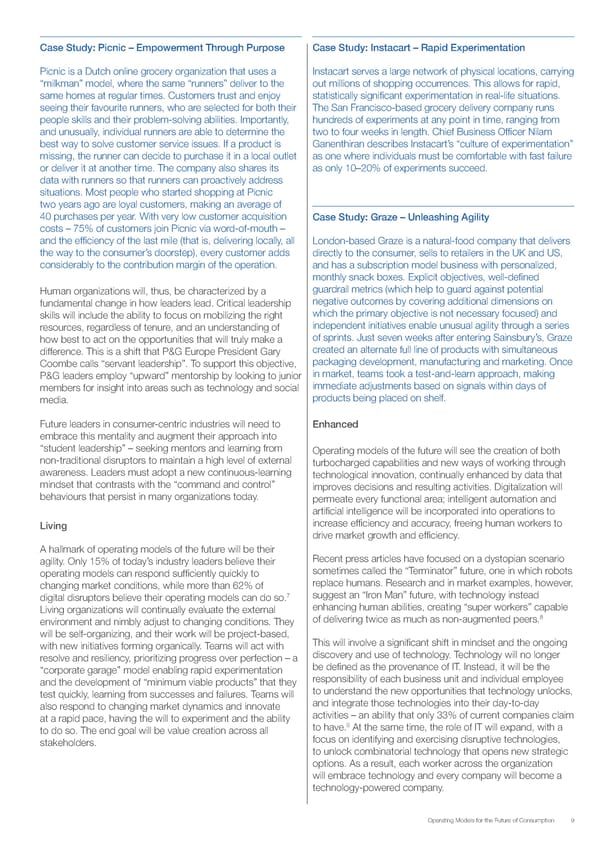Case Study: Picnic – Empowerment Through Purpose Case Study: Instacart – Rapid Experimentation Picnic is a Dutch online grocery organization that uses a Instacart serves a large network of physical locations, carrying “milkman” model, where the same “runners” deliver to the out millions of shopping occurrences. This allows for rapid, same homes at regular times. Customers trust and enjoy statistically significant experimentation in real-life situations. seeing their favourite runners, who are selected for both their The San Francisco-based grocery delivery company runs people skills and their problem-solving abilities. Importantly, hundreds of experiments at any point in time, ranging from and unusually, individual runners are able to determine the two to four weeks in length. Chief Business Officer Nilam best way to solve customer service issues. If a product is Ganenthiran describes Instacart’s “culture of experimentation” missing, the runner can decide to purchase it in a local outlet as one where individuals must be comfortable with fast failure or deliver it at another time. The company also shares its as only 10–20% of experiments succeed. data with runners so that runners can proactively address situations. Most people who started shopping at Picnic two years ago are loyal customers, making an average of 40 purchases per year. With very low customer acquisition Case Study: Graze – Unleashing Agility costs – 75% of customers join Picnic via word-of-mouth – and the efficiency of the last mile (that is, delivering locally, all London-based Graze is a natural-food company that delivers the way to the consumer’s doorstep), every customer adds directly to the consumer, sells to retailers in the UK and US, considerably to the contribution margin of the operation. and has a subscription model business with personalized, monthly snack boxes. Explicit objectives, well-defined Human organizations will, thus, be characterized by a guardrail metrics (which help to guard against potential fundamental change in how leaders lead. Critical leadership negative outcomes by covering additional dimensions on skills will include the ability to focus on mobilizing the right which the primary objective is not necessary focused) and resources, regardless of tenure, and an understanding of independent initiatives enable unusual agility through a series how best to act on the opportunities that will truly make a of sprints. Just seven weeks after entering Sainsbury’s, Graze difference. This is a shift that P&G Europe President Gary created an alternate full line of products with simultaneous Coombe calls “servant leadership”. To support this objective, packaging development, manufacturing and marketing. Once P&G leaders employ “upward” mentorship by looking to junior in market, teams took a test-and-learn approach, making members for insight into areas such as technology and social immediate adjustments based on signals within days of media. products being placed on shelf. Future leaders in consumer-centric industries will need to Enhanced embrace this mentality and augment their approach into “student leadership” – seeking mentors and learning from Operating models of the future will see the creation of both non-traditional disruptors to maintain a high level of external turbocharged capabilities and new ways of working through awareness. Leaders must adopt a new continuous-learning technological innovation, continually enhanced by data that mindset that contrasts with the “command and control” improves decisions and resulting activities. Digitalization will behaviours that persist in many organizations today. permeate every functional area; intelligent automation and artificial intelligence will be incorporated into operations to Living increase efficiency and accuracy, freeing human workers to drive market growth and efficiency. A hallmark of operating models of the future will be their agility. Only 15% of today’s industry leaders believe their Recent press articles have focused on a dystopian scenario operating models can respond sufficiently quickly to sometimes called the “Terminator” future, one in which robots changing market conditions, while more than 62% of replace humans. Research and in market examples, however, 7 suggest an “Iron Man” future, with technology instead digital disruptors believe their operating models can do so. Living organizations will continually evaluate the external enhancing human abilities, creating “super workers” capable 8 environment and nimbly adjust to changing conditions. They of delivering twice as much as non-augmented peers. will be self-organizing, and their work will be project-based, This will involve a significant shift in mindset and the ongoing with new initiatives forming organically. Teams will act with discovery and use of technology. Technology will no longer resolve and resiliency, prioritizing progress over perfection – a be defined as the provenance of IT. Instead, it will be the “corporate garage” model enabling rapid experimentation responsibility of each business unit and individual employee and the development of “minimum viable products” that they to understand the new opportunities that technology unlocks, test quickly, learning from successes and failures. Teams will and integrate those technologies into their day-to-day also respond to changing market dynamics and innovate activities – an ability that only 33% of current companies claim at a rapid pace, having the will to experiment and the ability 9 to do so. The end goal will be value creation across all to have. At the same time, the role of IT will expand, with a stakeholders. focus on identifying and exercising disruptive technologies, to unlock combinatorial technology that opens new strategic options. As a result, each worker across the organization will embrace technology and every company will become a technology-powered company. Operating Models for the Future of Consumption 9
 Operating Models for the Future of Consumption Page 8 Page 10
Operating Models for the Future of Consumption Page 8 Page 10